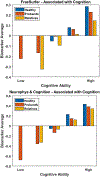Categorical and Dimensional Approaches for Psychiatric Classification and Treatment Targeting: Considerations from Psychosis Biotypes
- PMID: 39562461
- PMCID: PMC12054367
- DOI: 10.1007/978-3-031-69491-2_23
Categorical and Dimensional Approaches for Psychiatric Classification and Treatment Targeting: Considerations from Psychosis Biotypes
Abstract
Categorical diagnosis, a pillar of the medical model, has not worked well in psychiatry where most diagnoses are still exclusively symptom based. Uncertainty continues about whether categories or dimensions work better for the assessment and treatment of idiopathic psychoses. The Bipolar Schizophrenia Network for Intermediate Phenotypes (B-SNIP) examined multiple cognitive and electrophysiological biomarkers across a large transdiagnostic psychosis data set. None of the variables supported neurobiological distinctiveness for conventional clinical psychosis diagnoses but showed a continuum of severity. Using numerical taxonomy of these data, B-SNIP identified three biological subtypes (Biotypes) agnostic to DSM diagnoses. Biotype-1 is characterized by reduced physiological response to salient stimuli, while Biotype-2 showed accentuated intrinsic (background or ongoing) neural activity and the worst inhibition. Biotype-3 cases are like healthy persons on many laboratory measures. These Biotypes differed in imaging and other electrophysiological measures not included in subgroup creation, illustrating external validation. The Biotypes solution also replicated in an independent sample of psychosis cases. Biotypes are differentiable by clinical characteristics, leading to a feasible algorithm for Biotype estimates. Identifying Biotypes may aid treatment selection and outcome prediction. As an example, preliminary cross-sectional B-SNIP data suggest that Biotype-1 cases may have physiological features that predict a more favorable response to clozapine. While psychosis Biotypes reveal physiological heterogeneity across cases with similar clinical characteristics, data also suggest a dimensional vulnerability for serious psychopathology that cuts across diagnostic boundaries. Both categorical and dimensional diagnostic approaches should be considered within idiopathic psychosis for optimum diagnosis, care, and research.
Keywords: Biotypes; Categorical; Classification; Cognition; Dimensional; Physiology; Psychosis.
© 2024. The Author(s), under exclusive license to Springer Nature Switzerland AG.
Figures









References
-
- Adler LE, Pachtman E, Franks RD, Pecevich M, Waldo MC, Freedman R. Neurophysiological evidence for a defect in neuronal mechanisms involved in sensory gating in schizophrenia. Biol Psychiatry. 1982;17(6):639–54. - PubMed
-
- Alliey-Rodriguez N, Grey TA, Shafee R, Asif H, Lutz O, Bolo NR, Padmanabhan J, Tandon N, Klinger M, Reis K, Spring J, Coppes L, Zeng V, Hegde RR, Hoang DT, Bannai D, Nawaz U, Henson P, Liu S, Gage D, McCarroll S, Bishop JR, Hill S, Reilly JL, Lencer R, Clementz BA, Buckley P, Glahn DC, Meda SA, Narayanan B, Pearlson G, Keshavan MS, Ivleva EI, Tamminga C, Sweeney JA, Curtis D, Badner JA, Keedy S, Rapoport J, Liu C, Gershon ES. NRXN1 is associated with enlargement of the temporal horns of the lateral ventricles in psychosis. Transl Psychiatry. 2019;9(1):230. - PMC - PubMed
-
- Andreasen NC. The diagnosis of schizophrenia. Schizophr Bull. 1987;13(1):9–22. - PubMed
Publication types
MeSH terms
Substances
Grants and funding
LinkOut - more resources
Full Text Sources
Medical
Research Materials
